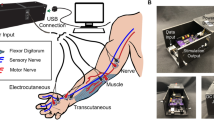Abstract
The non-invasive electrical stimulation of nerves requires neural stimulators with high voltage compliance to pass current through the skin and reach the targeted nerves. This study proposes a low-cost, microcontroller-based, wearable, high-voltage compliant current stimulator with four independent channels based on Components-Off-The-Shelf (COTS). The proposed system implements a voltage-current converter capable of generating custom stimulating waveforms with microseconds temporal resolution. The ±90 V voltage compliance enables the system to adapt to the possible variations in electrode-skin impedance during a daily life activity, allowing it to stimulate with currents up to 9 mA. The system was preliminary tested on humans using ultra-conformable Parylene-C based tattoo electrodes, showing the possibility of stimulating median and ulnar nerves and evoking sensation on the hand through more-than-wearable and completely unobtrusive technology.
Access this chapter
Tax calculation will be finalised at checkout
Purchases are for personal use only
Similar content being viewed by others
References
Cruccu, G., et al.: EAN guidelines on central neurostimulation therapy in chronic pain conditions. Eur. J. Neurol. 23(10), 1489–1499 (2016). https://doi.org/10.1111/ene.13103
Schuepbach, W.M.M., et al.: Neurostimulation for Parkinson’s disease with early motor complications. N. Engl. J. Med. 368(7), 610–622 (2013). https://doi.org/10.1056/NEJMoa1205158
Deer, T.R., et al.: The appropriate use of neurostimulation: new and evolving neurostimulation therapies and applicable treatment for chronic pain and selected disease states. Neuromodulation 17(6), 599–615 (2014). https://doi.org/10.1111/ner.12204
Bergey, G.K.: Neurostimulation in the treatment of epilepsy. Exp. Neurol. 244, 87–95 (2013). https://doi.org/10.1016/j.expneurol.2013.04.004
Bensmaia, S.J., Tyler, D.J., Micera, S.: Restoration of sensory information via bionic hands. Nat. Biomed. Eng. (2020). https://doi.org/10.1038/s41551-020-00630-8
D’anna, E., et al.: A closed-loop hand prosthesis with simultaneous intraneural tactile and position feedback. Sci. Robot. 4(27), eaau8892 (2019). https://doi.org/10.1126/scirobotics.aau8892
Raspopovic, S., et al.: Restoring natural sensory feedback in real-time bidirectional hand prostheses. Sci. Transl. Med. 6(222), 222ra19 (2014). https://doi.org/10.1126/scitranslmed.3006820
Petrini, F.M., et al.: Six-month assessment of a hand prosthesis with intraneural tactile feedback. Ann. Neurol. 85(1), 137–154 (2019). https://doi.org/10.1002/ana.25384
Tyler, D.J.: Neural interfaces for somatosensory feedback: bringing life to a prosthesis. Curr. Opinion Neurol. 28(6), 574–581 (2015). Lippincott Williams and Wilkins, https://doi.org/10.1097/WCO.0000000000000266
Middleton, A., Ortiz-Catalan, M.: Neuromusculoskeletal arm prostheses: personal and social implications of living with an intimately integrated bionic arm. Front. Neurorobot. 14, 39 (2020). https://doi.org/10.3389/fnbot.2020.00039
Cipriani, C., Segil, J.L., Clemente, F., Richard, R.F., Edin, B.: Humans can integrate feedback of discrete events in their sensorimotor control of a robotic hand. Exp. Brain Res. 232(11), 3421–3429 (2014). https://doi.org/10.1007/s00221-014-4024-8
D’Anna, E., et al.: A somatotopic bidirectional hand prosthesis with transcutaneous electrical nerve stimulation based sensory feedback. Sci. Rep. 7(1), 10930 (2017). https://doi.org/10.1038/s41598-017-11306-w
Scarpelli, A., Demofonti, A., Terracina, F., Ciancio, A.L., Zollo, L.: Evoking apparent moving sensation in the hand via transcutaneous electrical nerve stimulation. Front. Neurosci. 14, 534 (2020). https://doi.org/10.3389/fnins.2020.00534
Osborn, L.E., et al.: Prosthesis with neuromorphic multilayered e-dermis perceives touch and pain. Sci. Robot. 3(19), eaat3818 (2018). https://doi.org/10.1126/scirobotics.aat3818
Cordella, F., et al.: Literature review on needs of upper limb prosthesis users. Front. Neurosci. 10, 209 (2016)
Mascia, A., et al.: Wearable system based on ultra-thin Parylene C tattoo electrodes for EEG recording. Sensors 23(2), 766 (2023)
Collu, R., et al.: A wearable electronic system for EEG recording. In: 2022 17th Conference on Ph.D. Research in Microelectronics and Electronics (PRIME). IEEE (2022)
Spanu, A., et al.: Epidermal electrodes with ferrimagnetic/conductive properties for biopotential recordings. Bioengineering 9(5), 205 (2022)
Spanu, A., et al.: Parylene C-based, breathable tattoo electrodes for high-quality bio-potential measurements. Front. Bioeng. Biotechnol. 10, 820217 (2022)
Ferrari, L.M., et al.: Ultraconformable temporary tattoo electrodes for electrophysiology. Adv. Sci. 5(3), 1700771 (2018)
Günter, C., Delbeke, J., Ortiz-Catalan, M.: Safety of long-term electrical peripheral nerve stimulation: review of the state of the art. J. Neuroeng. Rehabil. 16, 1–16 (2019)
Demofonti, A., Scarpelli, A., Cordella, F., Zollo, L.: Modulation of sensation intensity in the lower limb via Transcutaneous Electrical Nerve Stimulation. In: 2021 43rd Annual International Conference of the IEEE Engineering in Medicine & Biology Society (EMBC), pp. 6470–6474. IEEE, November 2021
Demofonti, A., Scarpelli, A., Iannelli, V., Ciancio, A.L., Cordella, F., Zollo, L.: Somatotopical feedback restoration in the lower limb through TENS: a feasibility study. In: Convegno Nazionale di Bioingegneria, pp. 198–201 (2020)
Pan, L., Vargas, L., Fleming, A., Hu, X., Zhu, Y., Huang, H.H.: Evoking haptic sensations in the foot through high-density transcutaneous electrical nerve stimulations. J. Neural Eng. 17(3), 036020 (2020)
Collu, R., et al.: Wearable high voltage compliant current stimulator for restoring sensory feedback. Micromachines 14(4), 782 (2023)
Collu, R., Earley, E.J., Barbaro, M., Ortiz-Catalan, M.: Non-rectangular neurostimulation waveforms elicit varied sensation quality and perceptive fields on the hand. Sci. Rep. 13(1), 1588 (2023). https://doi.org/10.1038/s41598-023-28594-0
Valle, G., et al.: Comparison of linear frequency and amplitude modulation for intraneural sensory feedback in bidirectional hand prostheses. Sci. Rep. 8(1), 16666 (2018). https://doi.org/10.1038/s41598-018-34910-w
Karpul, D., Cohen, G.K., Gargiulo, G.D., Schaik, A., McIntyre, S., Breen, P.P.: Low-power transcutaneous current stimulator for wearable applications. Biomed. Eng. Online 16(1), 118 (2017). https://doi.org/10.1186/s12938-017-0409-9
Trout, M.A., Harrison, A.T., Brinton, M.R., George, J.A.: A portable, programmable, multichannel stimulator with high compliance voltage for noninvasive neural stimulation of motor and sensory nerves in humans. Sci. Rep. 13(1), 3469 (2023). https://doi.org/10.1038/s41598-023-30545-8
Acknowledgment
This study was partly supported by the European Union’s Horizon 2020 Research and Innovation Program under Grant agreement no. 899822 (SOMA project) and by the Italian Institute for Labour Accidents (INAIL) Prosthetic Center with WiFi-MyoHand project (CUP: E59E19001460005).
This work was partially funded by Fondazione di Sardegna, project BioVino (CUP F75F21001360007).
Author information
Authors and Affiliations
Corresponding author
Editor information
Editors and Affiliations
Rights and permissions
Copyright information
© 2024 The Author(s), under exclusive license to Springer Nature Switzerland AG
About this paper
Cite this paper
Collu, R. et al. (2024). A Microcontroller-Based Portable Transcutaneous Electrical Nerve Stimulator via Ultra-comfortable Tattoo Electrodes for Haptic Feedback. In: Ciofi, C., Limiti, E. (eds) Proceedings of SIE 2023. SIE 2023. Lecture Notes in Electrical Engineering, vol 1113. Springer, Cham. https://doi.org/10.1007/978-3-031-48711-8_47
Download citation
DOI: https://doi.org/10.1007/978-3-031-48711-8_47
Published:
Publisher Name: Springer, Cham
Print ISBN: 978-3-031-48710-1
Online ISBN: 978-3-031-48711-8
eBook Packages: EngineeringEngineering (R0)




